Hay (a word common in various forms to Teutonic languages; cf. Ger. Heu, Dutch hooi; the root from which it is derived, meaning “to cut,” is also seen in “to hew”; cf. “hoe”), grass mown and dried in the sun and used as fodder for cattle. It is properly applied only to the grass when cut, but is often also used of the standing crop. (See Haymaking below). Another word “hay,” meaning a fence, must be distinguished; the root from which it is derived is seen in its doublet “hedge,” cf. “haw-thorn,” i.e. “hedge thorn.” In this sense it survives in legal history in “hay bote,” i.e. hedge-bote, the right of a tenant, copyholder, &c. to take wood to repair fences, hedges, &c. (see Estovers), and also in “hayward,” an official of a manor whose duty was to protect the enclosed lands from cattle breaking out of the common land.
Haymaking.—The term “haymaking” signifies the process of drying and curing grass or other herbage so as to fit it for storage in stacks or sheds for future use. As a regular part of farm work it was unknown in ancient times. Before its introduction into Great Britain the animals intended for beef and mutton were slaughtered in autumn and salted down; the others were turned out to fend for themselves, and often lost all the fat in winter they had gained the previous summer. The introduction of haymaking gave unlimited scope for the production of winter food, and improved treatment of live stock became possible.
Though every country has its own methods of haymaking, the principal stages in the process everywhere are: (1) mowing, (2) drying or “making,” (3) “carrying” and storage in stacks or sheds.
In a wet district such as the west of Ireland the “making” is a difficult affair and large quantities of hay are often spoiled, while much labour has to be spent in cocking up, turning over, ricking, &c., before it is fit to be stacked up. On the other hand, in the dry districts of south-eastern England it is often possible to cut and carry the hay without any special “making,” as the sun and wind will dry it quickly enough to fit it for stacking up without the expenditure of much labour. This rule also applies to dry countries like the United States and several of the British colonies, and it is for this reason that most of the modern implements used for quickly handling a bulk of hay have been invented or improved in those countries. Forage of all kinds intended for hay should be cut at or before the flowering stage if possible. The full growth and food value of the plant are reached then, and further change consists in the formation and ripening of the seed at the expense of the leaves and stems, leaving these hard and woody and of less feeding value.
Grass or other forage, when growing, contains a large proportion of water, and after cutting must be left to dry in the sun and wind, a process which may at times be assisted by turning over or shaking up. In fine weather in the south of England grass is sufficiently dried in from two to four days to be stacked straight away. In Scotland or other districts where the rainfall is heavy and the air moist, it is first put into small field-ricks or “pykes” of from 10 to 20 cwt. each. In the drying process the 75% of water usually present in grass should be reduced to approximately 15% in the hay, and in wet or broken weather it is exceedingly difficult to secure this reduction. With a heavy crop or in damp weather grass may need turning in the swathe, raking up into “windrows,” and then making up into cocks or “quiles,” i.e. round beehive-like heaps, before it can be “carried.” A properly made cock will stand bad weather for a week, as only the outside straws are weathered, and therefore the hay is kept fresh and green. Indeed, it is a good rule always to cock hay, for even in sunny weather undue exposure ends in bleaching, which is almost as detrimental to its quality as wet-weathering.
In the last quarter of the 19th century the methods of haymaking were completely changed, and even some of the principles underlying its practice were revised. Generally speaking, before that time the only implements used were the scythe, the rake and the pitchfork; nowadays—with the exception of the pitchfork—these implements are seldom used, except where the work is carried on in a small way. Instead of the scythe, for instance, the mowing machine is employed for cutting the crop, and with a modern improved machine taking a swathe as wide as 5 or 6 ft. some 10 acres per day can easily be mown by one man and a pair of horses (figs. 1 and 2).
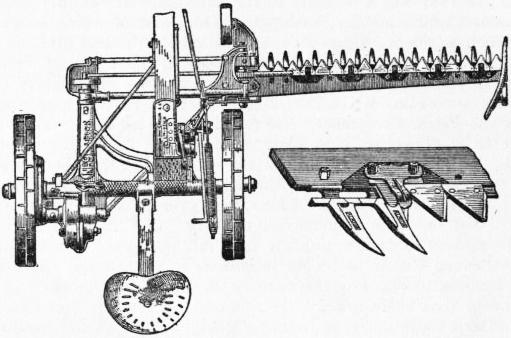 |
| Fig. 1.—Mower (viewed from above) with enlarged detail of Blade. (Harrison, M‘Gregor & Co.) |
It will be seen from the figures that a mower consists of three principal parts: (1) a truck or carriage on two high wheels carrying the driving gear; (2) the cutting mechanism, comprising a reciprocating knife or sickle operating through slots in the guards or “fingers” fastened to the cutting bar which projects to either the right or left of the truck; and (3) the pole with whipple-trees, by which the horses are attached to give the motive power. The reciprocating knife has a separate blade to correspond to each finger, and is driven by a connecting rod and crank on the fore part of the truck. In work the pointed “fingers” pass in between the stalks of grass and the knives shear them off, acting against the fingers as the crank drives them backwards and forwards. In the swathe of grass left behind by the machine, the stalks are, in a manner, thatched over one another, so that it is in the best position for drying in the sun, or, per contra, for shedding off the rain if the weather is wet. This is a great point in favour of the use of the machine, because the swathe left by the scythe required to be “tedded” out, i.e. the grass had to be shaken out or spread to allow it to be more easily dried.
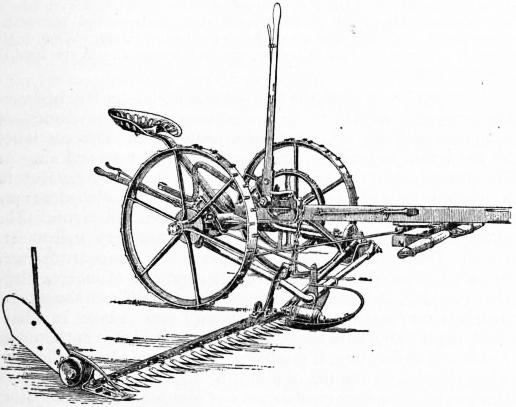 |
| Fig. 2.—Mower (side view). |
After the grass has lain in the swathe a day or two till it is partly dried, it is necessary to turn it over to dry the other side. This used to be done with the hand rake, and a band of men or women would advance in échelon across a field, each turning the swathe of hay by regular strokes of the rake at each step: “driving the dusky wave along the mead” as described in Thomson’s Seasons. This part of the work was the act of “haymaking” proper, and the subject of much sentiment in both prose and poetry. The swathes as laid by the mowing machine lent themselves to this treatment in the old days when the swathe was only some 3 to 4 ft. wide, but with the wide cut of the present day it becomes impracticable. If the hay is turned and “made” at all, the operation is now generally performed by a machine made for the purpose. There is a wide selection of “tedders” or “kickers,” and “swathe-turners” on the market. The one illustrated in fig. 3 is the first prize winner at the Royal Agricultural Society’s trials (1907). It takes two swathes at a time, and it will be seen that the working part consists of a wheel or circle of prongs or tines, which revolves across the line of the swathe. Each prong in turn catches the edge of the swathe of grass and kicks it up and over, thus turning it and leaving it loose for the wind to blow through.
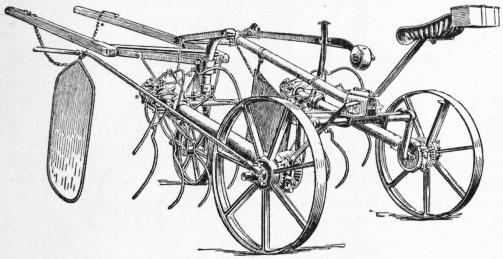 |
| Fig. 3.—Swathe-turner. (Blackstone & Co., Ltd.). |
The “kicker” is mounted on two wheels, and carries in bearings at the rear of the frame a multiple-cranked shaft, provided with a series of forks sleeved on the cranks and having their upper ends connected by links to the frame. As the crankshaft is driven from the wheels by proper gearing the forks move upward and forward, then downward and rearward, in an elliptical path, and kick the hay sharply to the rear, thus scattering and turning it.
It is a moot point, however, whether grass should be turned at all, or left to “make” as it falls from the mowing machine. In a dry sunny season and with a moderate crop it is only a waste of time and labour to turn it, for it will be cured quite well as it lies, especially if raked up into loose “windrows” a little before carrying to the stack. On the other hand, where the crop is heavy (say over 2 tons per acre) or the climate is wet, turning will be necessary.
With heavy crops of clover, lucerne and similar forage crops, turning may be an absolute necessity, because a thick swathe of a succulent crop will be difficult to dry or “make” excepting in hot sunny weather, but with ordinary meadow grass or with a mixture of “artificial” grasses it may often be dispensed with. It must be remembered, however, that the process of turning breaks the stalks (thus letting out the albuminoid and saccharine juices), and should be avoided as far as possible in order to save both labour and the quality of the hay.
One of the earlier mechanical inventions in connexion with haymaking was that of the horse rake (fig. 4). Before its introduction the hay, after making, had to be gathered up by the hand rake—a tedious and laborious process—but the introduction of this implement, whereby one horse and one man can do work before requiring six or eight men, marked a great advance. The horse rake is a framework on two wheels carrying hinged steel teeth placed 3 in. apart, so that their points slide along the ground below the hay. In work it gathers up the loose hay, and when full a tipping mechanism permits the emptying of the load.
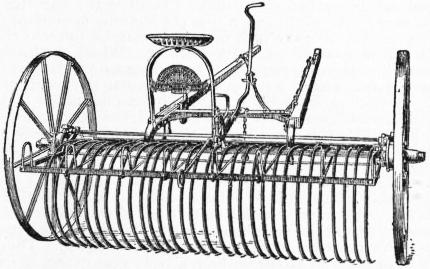 |
| Fig. 4.—Self-acting Horse Rake. (Ransomes, Sims & Jefferies, Ltd.). |
The tipping is effected by pulling down a handle which sets a leverage device in motion, whereby the teeth are lifted up and the load of hay dropped below and left behind. On some rakes a clutch is worked by the driver’s foot, and this put in action causes the ordinary forward revolving motion of the driving wheels to do the tipping.
The loads are tipped end to end as the rake passes and repasses at the work, and thus the hay is left loose in long parallel rows on the field. Each row is termed a “windrow,” the passage of the wind through the hay greatly aiding the drying and “making” thereof. When hay is in this form it may either be carried direct to the stack if sufficiently “made,” or else put into cocks to season a little longer. The original width of horse rakes was about 8 ft., but nowadays they range up to 16 and 18 ft. The width should be suited to that of the swathes as left by the mower, and as the latter is now made to cut 5 and 6 ft. wide, it is necessary to have a rake to cover two widths. The very wide rakes are only suitable for even, level land; those of less width must be used where the land has been laid down in ridge and furrow. As the swathes lie in long parallel rows, it is a great convenience in working for two to be taken in width at a time, so that the horse can walk in the space between.
The side-delivery rake, a development of the ordinary horse rake, is a useful implement, adapted for gathering and laying a quantity of hay in one continuous windrow. It is customary with this to go up the field throwing two swathes to one side, and then back down on the adjacent swathes, so that thus four are thrown into one central windrow. The implement consists of a frame carried on two wheels with shafts for a horse; across the frame are fixed travelling or revolving prongs of different varieties which pick up the hay off the ground and pass it along sideways across the line of travel, leaving it in one continuous line. Some makes of swathe-turners are designed to do this work as well as the turning of the hay.
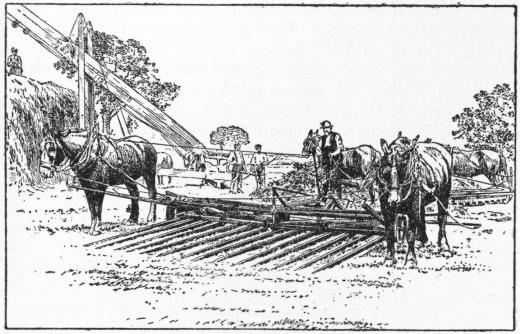 |
| Fig. 5.—Sweep Rake. |
Perhaps the greatest improvement of modern times is the method of carrying the hay from the field to the stack. An American invention known as the sweep rake was introduced by the writer into England in 1894, and now in many modified forms is in very general use in the Midlands and south of England, where the hay is carried from the cock, windrow or swathe straight to the stack. This implement consists of a wheeled framework fitted with long wooden iron-pointed teeth which slide along the ground; two horses are yoked to it—one at each side—the driver directing from a central seat behind the framework. When in use it is taken to the farther end of a row of cocks, a windrow, or even to a row of untouched swathes on the ground, and walked forward. As it advances it scoops up a load, and when full is drawn to where the stack is being erected (fig. 5). In ordinary circumstances the sweep rake will pick up at a load two-thirds of an ordinary cart-load, but, where the hay is in good order and it is swept down hill, a whole one-horse cart-load can be carried each time. The drier the hay the better will the sweep rake work, and if it is not working sweetly but has a tendency to clog or make rolls of hay, it may be inferred that the latter is not in a condition fit for stacking. Where the loads must be taken through a gateway or a long distance to the stack, it is necessary to use carts or wagons, and the loading of these in the field out of the windrow is largely expedited by the use of the “loader,” also an American invention of which many varieties are in the market. Generally speaking, it consists of a frame carrying a revolving web with tines or prongs. The implement is hitched on behind a cart or wagon, and as it moves forward the web picks the loose hay off the ground and delivers it on the top, where a man levels it with a pitchfork and builds it into a load ready to move to the stack. At the stack the most convenient method of transferring the hay from a cart, wagon or sweep rake is the elevator, a tall structure with a revolving web carrying teeth or spikes (fig. 6). The hay is thrown in forkfuls on at the bottom, a pony-gear causes the web to revolve, and the hay is carried in an almost continuous stream up the elevator and dropped over the top on to the stack. The whole implement is made to fold down, and is provided with wheels so that it can be moved from stack to stack. In the older forms there is a “hopper” or box at the bottom into which the hay is thrown to enable the teeth of the web to catch it, but in the modern forms there is no hopper, the web reaching down to the ground so that hay can be picked up from the ground level. Where the hay is brought to the stack on carts or wagons it can be unloaded by means of the horse fork. This is an adaptation of the principle of the ordinary crane; a central pole and jib are supported by guy ropes, and from the end of the jib a rope runs over a pulley. At the end of this rope is a “fork” formed of two sets of prongs which open and shut. This is lowered on to the load of hay, the prongs are forced into it, a horse pulls at the other end of the rope, and the prongs close and “grab” several cwt. of hay which are swung up and dropped on the stack. In this way a large cart or wagon load is hoisted on to the stack in three or four “forkfuls.” The horse fork is not suited for use with the sweep rake, however, because the hay is brought up to the stack in a loose flat heap without sufficient body for the fork to get hold of.
In northern and wet districts of England it is customary to “make” the hay as in the south, but it is then built up into little stacks in the field where it grew (ricks, pykes or tramp-cocks are names used for these in different districts), each containing about 10 to 15 cwt. These are made in the same way as the ordinary stack—one person on top building, another on the ground pitching up the hay—and are carefully roped and raked down. In these the hay gets a preliminary sweating or tempering while at the same time it is rendered safe from the weather, and, thus stored, it may remain for weeks before being carried to the big stacks at the homestead. The practice of putting up the hay into little ricks in the field has brought about the introduction of another set of implements for carrying these to the stackyard.
Various forms of rick-lifters are in use, the characteristic feature of which is a tipping platform on wheels to which a horse is attached between shafts. The vehicle is backed against a rick, and a chain passed round the bottom of the latter, which is then pulled up the slant of the tipped platform by means of a small windlass. When the centre of the balance is passed, the platform carrying the rick tips back to the level, and the whole is thus loaded ready to move. Another variety of loader is formed of three shear-legs with block and tackle. These are placed over a rick, under which the grab-irons are passed, and the whole hauled up by a horse. When high enough a cart is backed in below, the rick lowered, and the load is ready to carry away.
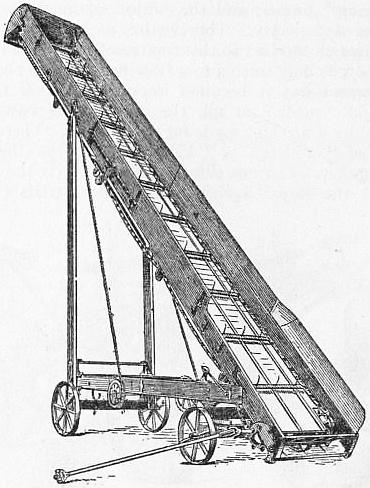 |
| Fig. 6.—Hay Elevator. (Maldon Iron Works Co.). |
When put into a stack the next stage in curing the hay begins—the heating or sweating. In the growing plants the tissues are composed of living cells containing protoplasm. This continues its life action as long as it gets sufficient moisture and air. As life action involves the development of heat, the temperature in a confined space like a stack where the heat is not dissipated may rise to such a point that spontaneous combustion occurs. The chemical or physical reasons for this are not very well understood. The starch and sugar contents of the tissues are changed in part into alcohol. In the analogous process of making silage (i.e. stacking wet green grass in a closed building) the alcohol develops into acetic acid, thus making “sour” silage. In a haystack the intermediate body, acetaldehyde, which is both inflammable and suffocating, is produced—men having been suffocated when sleeping on the top of a heating stack. The production of this gas leads to slow combustion and ignition. One explanation of the process is that the protoplasm of the cells acts as a fermenting agent (like yeast) until a temperature sufficient to kill germ life, say 150° F., is reached, beyond which the action which leads up to the temperature of ignition must be purely chemical. If the stack contains no air at all it does not heat, or if it has excess of air it is safe. The danger-point in a stack is the centre at about 6 ft. from the ground; below this the weight of the hay itself squeezes out the air, and at the sides and top the heat is dissipated outwards. If a stack shows signs of overheating (a process that may take weeks or even months to develop) it can be saved by cutting a gap in the side of it with the hay knife, thus letting out the heat and fumes, and admitting fresh air to the centre. The essential point in haymaking is that the hay should be dried sufficiently to ensure the sweating process in the stack reaching no further than the stage of the formation of sugar. Good hay should come out green and with the odour of coumarin—to which is due the scent of new-mown hay. Only part of a stack can ever attain to a perfect state: the tops, bottom and outsides are generally wasted by the weather after stacking, while there may be three or four intermediate qualities present. In some markets hay that has been sweated till it is brown in colour is desired, but for general purposes green hay is the best.
Hay often becomes musty when the weather during “making” has been too wet to allow of its getting sufficiently dry for stacking. Mustiness is caused by the growth of various moulds (Penicillium, Aspergillus, &c.) on the damp stems, with the result that the hay when cut out for use is dusty and shows white streaks and spots. Such hay is inferior to that which has been overheated, and in practice it is found that a strong heating will prevent mouldiness by killing the fungi.
Heavy lush crops—especially those containing a large proportion of clover or other leguminous plants—are proportionately more difficult to “make” than light grassy ones. Thus, if one ton is taken as a fair yield off one acre, a two-ton crop will probably require four times as much work in curing as the smaller crop. In the treacherous climate of Great Britain hay is frequently spoiled because the weather does not hold good long enough to permit of its being properly “made.” Consequently many experienced haymakers regard a moderate crop as the more profitable because it can be stacked in first-class condition, whereas a heavy crop forced by “high farming” is grown at a loss, owing to the weather waste and the heavier expenses involved in securing it.
In handling or marketing out of the stack hay may be transported loose on a cart or wagon, but it is more usual to truss or bale it. A truss is a rectangular block cut out of the solid stack, usually about 3 ft. long and 2 ft. wide, and of a thickness sufficient to give a weight of 56 ℔: thirty-six of these constitute a “load” of 18 cwt.—the unit of sale in many markets. A truss is generally bound with two bands of twisted straw, but if it has to undergo much handling it is compressed in a hay-press and tied with two string bands. In some districts a baler is used: a square box with a compressible lid. The hay is tumbled in loose, the lid forced down by a leverage arrangement and the bale tied by three strings. It is usually made to weigh from 1 to 1½ cwt. The customs of different markets vary very much in their methods of handling hay, and in the overseas hay trade the size and style of the trusses or bales are adapted for packing on ship-board.


